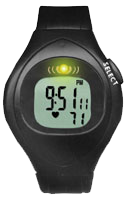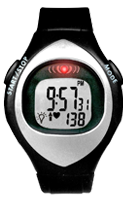Which heart rate monitor is best for you — digital or analog?

One Button Analog Blink Heart Rate Monitor
As a heart rate monitor, i.e. ZONING fitness enthusiast, you can now choose between two different types of heart rate monitors — digital or analog. But, what is the difference between a digital and an analog heart rate monitor? And which of the two is best for you? The answer lies in the transmission of the heart rate number, the bpm or beats-per-minute. And that transmission — that wave or that binary code — can make all of the differences to you.
8/14 UPDATE: I have posted a new review about what I feel is the best indoor cycling heart rate monitor strap.
First, both digital and analog heart rate monitor transmitter belts detect the same electrical activity of the heart”™s contraction using sensors. The sensor in your transmitter belt can be viewed by looking at the back side of the belt which goes next to your skin. On each side of the elastic strap there is a soft and black rubber-like material that is usually oval in shape. There are always two the sensors — one on each side of the transmitter — that detect the electrical changes in the heart beat by using the amplitude of the EKG wave of the heart muscle.
Both digital and analog transmitter belts and watches are equally accurate. What is different is how they transmit the beats-per-minute of the heartbeat to the wrist top watch. And, that watch must either have a digital or an analog receiver that can accept that signal and convert it to a number that displays on our wrist or on your forearm or on your mobile device like an iPhone.
Analog transmission uses signals to the watch that are exact replicas of a sound wave. Analog signals can interfere with other nearby signals and this challenge is called the “cross talk” of two signals. The main advantages of analog heart rate monitors are the following:
- Compatible with most, now about 99%, of the cardio machines at the gym,
- Analog transmitters and receivers in the watch are less expensive
- The signal is carried through water so swimmers and those doing water activities can use a heart rate monitor.
The disadvantage of analog heart rate monitors is that if you are within 3 feet of another analog wave transmitter which can be another person wearing a transmitter belt or another source of an analog signal you will experience “cross talk”. In this case, the receiver in the heart watch will accept both signal sources and add them together and you will get an incorrect number until there is only one signal for the receiver to sense.

Two Button Blink Digital Heart Rate Monitor
Digital transmission converts the heart”™s EKG activity into a digital signal using binary code which is made up of 0s and 1s. Digital transmission is a clearer signal because it is impossible with packets of data rather than analog wave signals for interference. Digital heart rate monitors are more expensive yet have the following advantages:
- The technology is newer
- Digital signals do not interfere or “cross talk with other users or other signals.
- Digital signals can be used with Bluetooth and ANT+ receivers in mobile devices like iPhones and others tools.
Digital heart rate monitors will not work for most swimmers because digital signals do not transmit from the transmitter to the watch under water. Here”™s an example for you. If you are working out with another person who is using a heart rate monitor, the digital monitor is better because it will not receive both watches data and hence cross talk or allow interference.
What”™s the best heart rate monitor for you — digital or analog? The answer is simple: it depends. It depends on price with analog less expensive, it depends if you are working out with others, digital is better because there is no cross talk, and if you are a triathlete or a swimmer — well — it depends because you cannot use it for swimming. My answer — just get a digital and get a less expensive analog and you have the best of both worlds.
Sally Edwards, author
ZONING, Fitness in a Blink
The Heart Rate Monitor GUIDEBOOK
This was originally posted by Sally at http://zoningfitness.com/blog/heart-rate-training-for-weight-loss/which-heart-rate-monitor-is-best-for-you-digital-or-analog/
- Heart Rate Display Training Contributes to Women's World Cup Victory - July 6, 2015
- Tech Tuesday – Which Heart Rate Monitor is Best? - July 17, 2012

I have an upcoming interview with an Instructor who is making hundreds of dollars a weekend teaching “Introduction to Heart Rate Training” classes at his club. Look for it in early August.
As I was involved in the development of the Blink digital heart rate monitors I’m sure Sally would want me to share these thoughts.
We’ve been trying to get heart rate monitors onto our riders for years. Until now, the facilities that successfully integrated HR were driven by management. Management invested in ways to make it work which usually means the instructor had to figure it out. Still cross talk was/is an issue
For the rest of us not so lucky to have the backing of the facility, if and when we got our riders wearing the monitor they were plagued with ‘cross talk’ issues which quickly turned the possibility of a great experience into an unpleasant one. Result, riders stop wearing them. That not the goal. Additionally, because of such ‘crosstalk’ issues we hold on to RPE and verbal descriptors that mean something different to everyone.
Since we are mostly group exercise instructors with a bent on indoor cycling I’d like to offer these recommendations.
For Group exercise use ‘digital’. ESPECIALLY INDOOR CYCLING. Our bikes are often grouped closely. Indoor cycling was the primary motivator to develop, invest and go digital with the Blink. Indoor cycles don’t move and which wrist people wear their monitor on can change everything. Although 36 inches to one meter is the recommended distance between analog receivers (the wrist top watch) transmission power tends to vary. I’ve seen them work at twice that distance. So group exercise, spend a few extra bucks, go digital.
With digital Blink heart rate monitors on our riders, an instructor has the opportunity to bring the two threshold/three zone heart rate exercise program, ZONING into the studio. It is easy for everyone to understand and implement. (See my audio podcast on teaching to the blue yellow and red) It easily connects the mind and the body through the simple use of color coded flashing lights and perhaps most importantly, STANDARDIZES the discussion of effort managment.
In other group exercises, rooms were bigger or participants moved around relative to each other. There was ‘crosstalk’ but not so much. These group exercisers and instructors could also gain from integrating the 2T/3Z systems.
For solo runners or cycling out doors and of course swimming, analog works just fine.
The only downside to digital is that it won’t likely be read by the machines at the gym or the new bikes which sense HR. However, you have the wrist top watch for that, so not really a down side at all.
One last point. Sally and I worked long and hard with our vendor to be sure the price point (MSRP) for our most expensive digital HR monitor is still a great value compared to other manufacturers digital products. check it out.
Heart Rate training has changed my life in many ways. Now we can offer this great experience to our riders with no interference.
Heart rate training can and will change your life as an instructor. Share it with your riders.
You know this, ICI Pro JOHN and ZONING Chuck – there are three ways to workout on a bike: guessing, RPE (rating of perceived exertion), or heart rate … and the best way, truly the only way to effectively save time and get results is with HRM, heart rate monitor training. That means ZONING…and it’s patented that’s how much the federal government loves ZONING! SALLY
PS I look forward to your upcoming guest on the topic of making a profit, positive revenue, by programming with heart rate technology….that will be great!
You should also mention that there are analog coded transmitters such as the Polar T-31 that can prevent crosstalk when paired with a coded capable receiver.